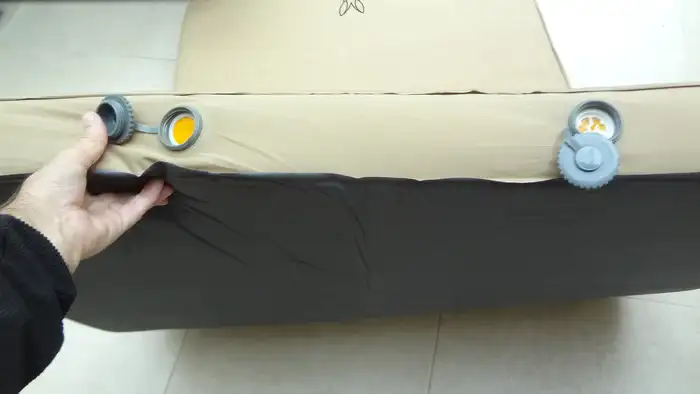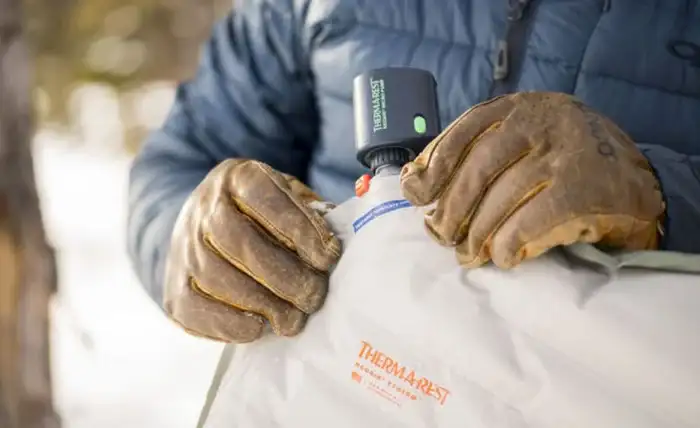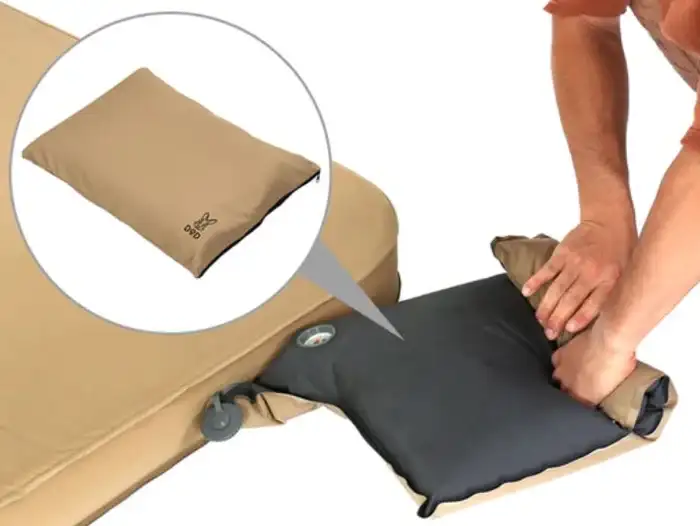A self-inflating mattress inflates by itself when its inner foam expands, but when it is time to go you have to do some work. Here I describe the steps that are dependent on several factors.
Self-inflating pads can be bulky and hard to deflate because of open-cell foam inside. Deflation steps will depend on the type of valves that it has, and on the width of the pad.
But quite generally, you can deflate a sleeping pad in two ways:
- Manually.
- Using a deflator pump.
For manual deflation, you will roll it at least twice, and do not hesitate to use your knees to keep it rolled and compressed in the process. But it is far easier to do this with a battery-operated pump.

Manual deflation dependent on the types of valves
A self-inflating pad may have one or two valves. Now, these valves can be the following type:
Type 1: Separate valves for inflation and deflation. The valve is built to let the air pass only in one direction, and it is described as a one-way valve or one-function valve. So simply open the deflation valve before you start rolling and compressing the pad in the direction of the valve.
Type 2: The valves can be two-way type with a rotating core or with some other mechanism, so each of them can be used for both inflation and deflation.
A pad can have one valve of this type and this is enough, but better pads have them two to speed up the process. So for deflation set the valve(s) to the corresponding function and then roll and compress.
The picture below shows my DoD Soto Sleeping Pad with its 2 two-way valves. I have rotated them to show their two sides, so on the left is the deflation side and on the right the inflation side. If I want to deflate, I shall rotate them both to be as the one on the left.

Type 3: A very simple design where the same valve is used for both inflation and deflation, but there is no core that would change its function, and there is no mechanism to prevent the air getting back if the foam expands accidentally.
In this case it is important to keep the pad compressed all the time so that it does not suck the air back into the pad.
The deflation procedure also depends on the width of the pad.
- If this is a single pad, you will simply start rolling from the side opposite to the deflation valve(s). But make sure that the valve(s) is (are) set to deflation. After the first roll, you unroll it and roll again. You can also fold it width-wise, then roll and compress again.
- If this is a very wide pad or a double-wide pad, you will probably have to fold it in half width. However, this may be difficult if it is thick. In this case roll it as it is and keep compressed so that you force the air out. Then unroll it, and after that fold it in half width and start rolling again.
- In the case of the Type 3 mentioned above, you will do the same steps, but make sure that you keep the pad constantly compressed. Otherwise, it will suck the air in. This means also that before the second rolling/compression, you will have to close the valve before you unfold it after the first rolling/compression.
The man in the video below is showing how this is done. Note that here the pad has separate valves, so this is the Type 1, one of Exped sleeping pads.
Sleeping pad deflation with the help of a pump
Some brands have their battery-operated deflation pump specially designed for their self-inflating sleeping pads. One great example is Therm-a-Rest that has many pads on the market.

For such pads they have quite a number of accessories and those include also their Therm-a-Rest NeoAir Micro Electric Air Pump for Sleeping Pads shown above. It works both ways, for inflation and deflation, you can see in this video how it works:
Note that there are many other pumps of this type on the market, some of them are available on Amazon and you can see them here.
How does self inflate mattress work?
The inflation and deflation of a self-inflating pad are based on the features of its inner open-cell foam. When you decompress such a pad with the open valve, the elasticity of the foam will start working.
So as the foam slowly takes its shape, it will suck the air through the valve in. If you have a thick pad, you will be able to hear the sound of air that is rushing into the pad.
Some pads have cut-outs in the foam to make self-inflating faster and also to reduce the weight. You can see this in the DeltaCore design in the Sea to Summit Comfort Deluxe SI Sleeping Pad:

Usually, you will have to blow a bit of extra air by mouth or by some other means to make the pad firm and fully inflated.
How comfortable are self inflating mattresses?
I am sure that the most comfortable are the simple foam pads. This is because such pads are breathable and they are not with an air tight shell, so you will not sweat as much as with some other types.
But those foam pads are usually the bulkiest, so the next best option is a self-inflating mattress. I have a few of them and I use them mostly for car camping, and one of them is light enough and compact enough to be carried in the pack.
In short, these pads are indeed comfortable, but it is important to inflate it properly, I would say it is better less than too much.
How thick should a self inflating camping mattress be?
This is related to comfort, and it will depend on how you use it. If you want a pad for the trail, you will have to go for a very thin pad because this means less volume and weight. In this case you will have to be satisfied with 2-3 cm thickness.
But if this is about car camping, the more the better. You have seen my Soto pad, it is 10 cm thick and this is more than enough. There is no way to feel the ground when you have such a pad underneath you.
How do you pump up a self inflating mattress?
Self-inflating pads will inflate if you simply open the valves. But this is usually not enough. So you can blow the air a few times by mouth.
Some better design include a pillow that doubles as a manual pump, this is what I have in the mentioned DoD Soto Sleeping Pad (see the picture below), or the stuff sack of the pad doubles as a pad. You can also use a battery powered pump.

How long does it take for self inflating mattress?
This depends on the thickness. Thinner pads will inflate in a few minutes after you open the valve.
But note that the first time you use it, it may take hours. This is because the foam inside must regain its elasticity after it has been compressed for a very long period of time.
So do not panic if you notice that the progress is slow, and do not think that something is wrong. Just give it a time, but if you have no time, inflate it in any other way mentioned above.
Are self inflating mattresses warm?
The answer is yes in the sense that such a pad will insulate you from the ground. The foam inside keeps the air mostly in place, so it does not move long distances and this is why such a pad works great.
Almost any self-inflating pad may be good enough for all seasons. But make sure that its R-value is above 4 or 5 if this is about winter camping.
Conclusion
In summary, self-inflating pads do need some work when it is time to deflate them, but this is always a simple procedure. For manual deflation, use your body weight, knees for example, to keep the pad rolled and compressed in the process. With a bit of practice you will master this quickly.
But if you want to do this really easy, use a pump, it will deflate the pad better than what you can do manually.
Thank you for reading. This site is all about outdoors, and I add texts here on a regular basis, so bookmark it and keep as a reference. Please use the comment box below in the case of questions or comments. Have a nice day.
Leave a Reply